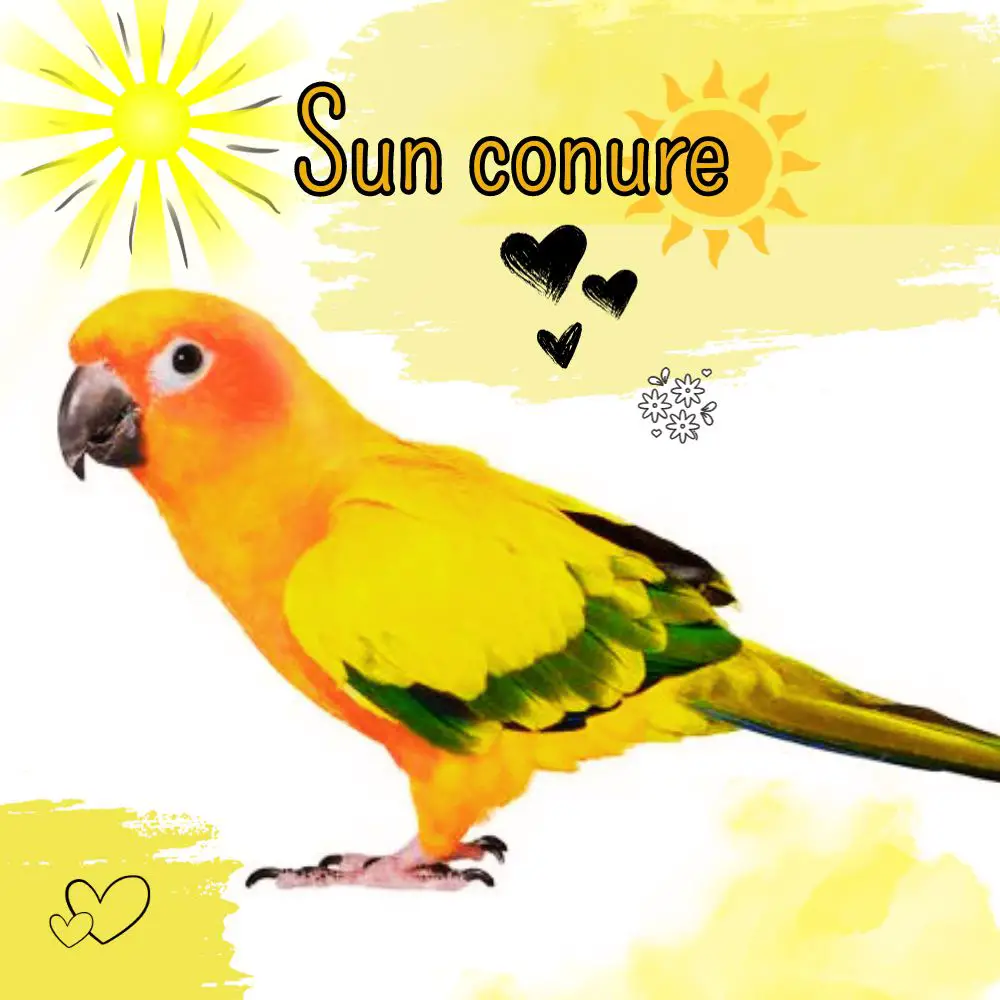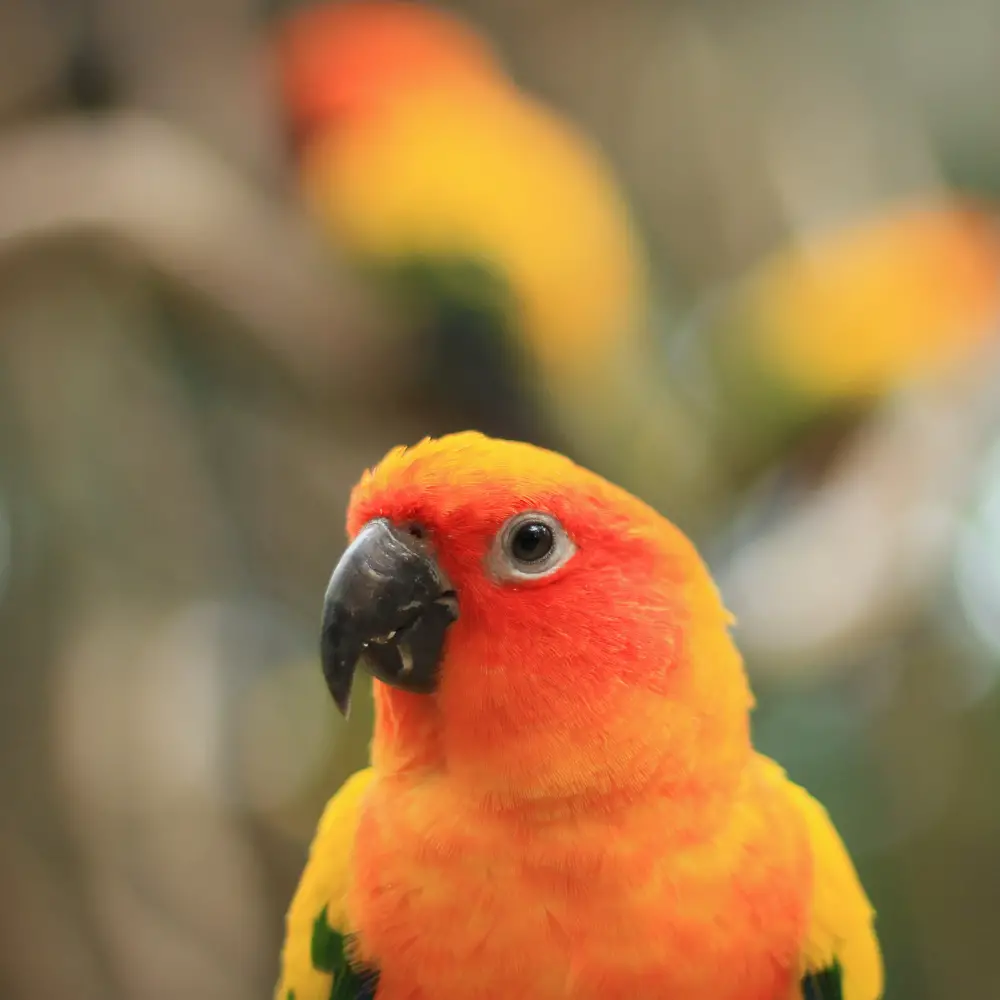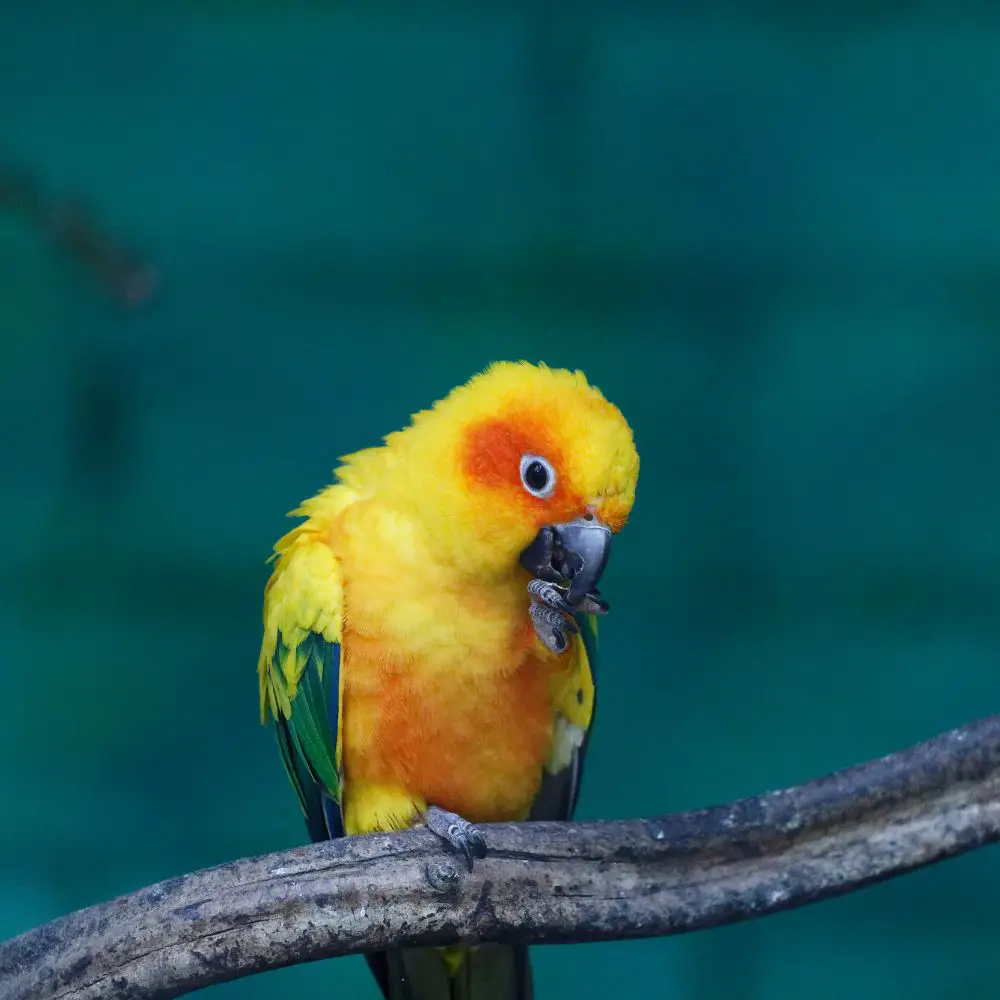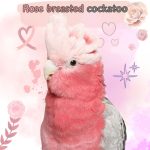
Lively, playful, curious, and sociable, the Sun Conure is an excellent domestic bird that will delight the whole family. But behind his docility, there is also a strong character that must be learned to master.
Two plumage mutations are found in the Sun Parakeet in captivity.
The best known is the Red Postman Sun Conure whose plumage displays magnificent shades of red with bright green and yellow wings as well as sometimes some feathers in shades of blue.
The second mutation, rarer, is called the Sun Conure yellow mutation whose color is entirely yellow with a shade of orange on the head and belly.
Despite their average size, Sun Conures are much more robust than they appear. They have a small round head for females and a flatter, square forehead for males. Their eyes are black with a white eye ring and their beak is also black. Their legs are brown, slightly tiger-like.
In young Conures, the plumage is more green and less vivid and shiny than in adults. The feathers change as the bird ages, eventually taking on splendid red and orange colors.
Weight: between 110 and 130g depending on sex, females being lighter
Size: 20 to 25 cm, up to 30cm for the largest specimens.
Sun conure personality

The Sun Conure is an extremely curious parrot who will be interested in everything around him! This is a bird that will enjoy exploring the nooks and crannies of its cage and all the rooms to which it has access. Very attentive, the Conure will observe all your actions with interest and will love to interact with you.
Like many birds of this species, the Sun Conure can be a real little clown who will enjoy playing, climbing, and climbing all kinds of things. It will be essential to equip his cage with enough toys to keep him occupied.
The Sun Conure is one of the rare parrots that appreciates affection and will never be against petting and petting. It is therefore important to be able to give her several hours a day to play with her and give her the affection she needs. Otherwise, she could quickly feel unhappy. But be careful, she can also be very temperamental and you should not hesitate to raise your voice to be listened to.
Do not expect the Conure to be talkative. Indeed, although she can pronounce a few words after long training, her vocabulary is rather limited and she will be more adept at whistling than speaking.
Sun conure lifespan
The Sun Conure can live up to 30 years if it lives in an environment conducive to good health. This is therefore a long-term commitment that will need to be thought through carefully.
Sun conure sound
SOURCE: African Grey Parrot Pet
In captivity, this bird’s loud and harsh calls may lead to calls from angry neighbors. The Sun Conure parrot is not suitable for residents of apartments or residential units, and you cannot expect to move away from its calls, but you can train it from an early age to limit Excessive screaming. It expresses excitement and fear with intense screams.
The Sun Conure parrot is not a shy bird and will let you know vocally if it feels bored or if its needs are neglected. The Sun Conure parrot is not known for its ability to speak, but some birds show an uncanny ability to imitate other types of sounds. Such as doorbells, microwave chimes, and telephone chimes.
How to tame a sun conure

As with all birds, proper exercise is essential for good health. The Sun Conure parrot is by nature very active and needs enough space to fly, explore, and play.
The Sun Conure parrot must be allowed out of the cage for at least 3 hours every day. Foraging and other forms of enrichment are essential for these intelligent parrots, and be sure to provide the bird with a variety of fun toys and change them at regular intervals to prevent your pet from getting bored.
Advantages of Sun Conure parrot:
- Social, affectionate and lovable
- Smart and can learn tricks
- One of the most vibrantly colored birds
Disadvantages of Sun Conure parrot:
- Noisy and not suitable for apartments or nearby neighbors
- Not known for his speaking ability
- Can get aggressive with children if provoked
How do you keep a sun conure healthy?
As with other birds of its species, the Sun Parakeet is prone to plantar abscesses caused by perches that are sometimes unsuitable for the bird’s legs. If you notice any abnormal redness, swelling, or lesions, consider a visit to the veterinarian to make sure she is not unwell.
She can also contract fungal infections which manifest as difficulty breathing, coughing, and remarkable weakness.
Depression is common in neglected pet birds, so it’s important to make time for playtime every day.
More serious, it can develop a disease common in parakeets, namely beak and feather disease which is characterized by abnormal growth of the beak and claws as well as loss of feathers and infections. This disease greatly affects the bird’s immune system and no treatment is currently possible.
In general, you should not hesitate to consult at the slightest abnormal signs.
Sun conure care

The Sun Parakeet likes to be able to fly in large, airy spaces. So to guarantee its well-being it will be better to provide an aviary at least 1m60 high and 2m wide. Conversely, a large cage will do the trick but life in semi-freedom will be recommended to allow him to stretch his wings every day.
Being very curious and active, his environment must be equipped with enough accessories to occupy him and allow him to exercise and stimulate his senses.
It is a day bird, so offer it a nest of at least 30 x 30 cm so that it can spend the night there without being cramped.
It is recommended to trim its claws to prevent them from becoming too long and causing the Conure to injure itself.
To allow him to use his beak, you will need to provide him with hard objects such as wood. However, it is not uncommon for captive birds to develop growth, a visit to the veterinarian will allow it to be trimmed for maximum comfort.
The Conure loves the shower! Provide her with a bathtub so that she can soak in it and get rid of the dirt. But be careful not to let her swim unsupervised. You can also spray him with a little water using a mister if he wishes. She will then open her wings and enjoy this moment!
Sun conure food

The Sun Parakeet feeds on fruits, seeds, and nuts. For his well-being, it is important to offer him a varied diet and not be satisfied with pet store mixes.
Generally, the most balanced diet consists of 50% mixed seeds, 45% vegetables, and 5% fruits and nuts.
Don’t forget to provide him with a cuttlefish bone which contains all the minerals essential to his health.




















